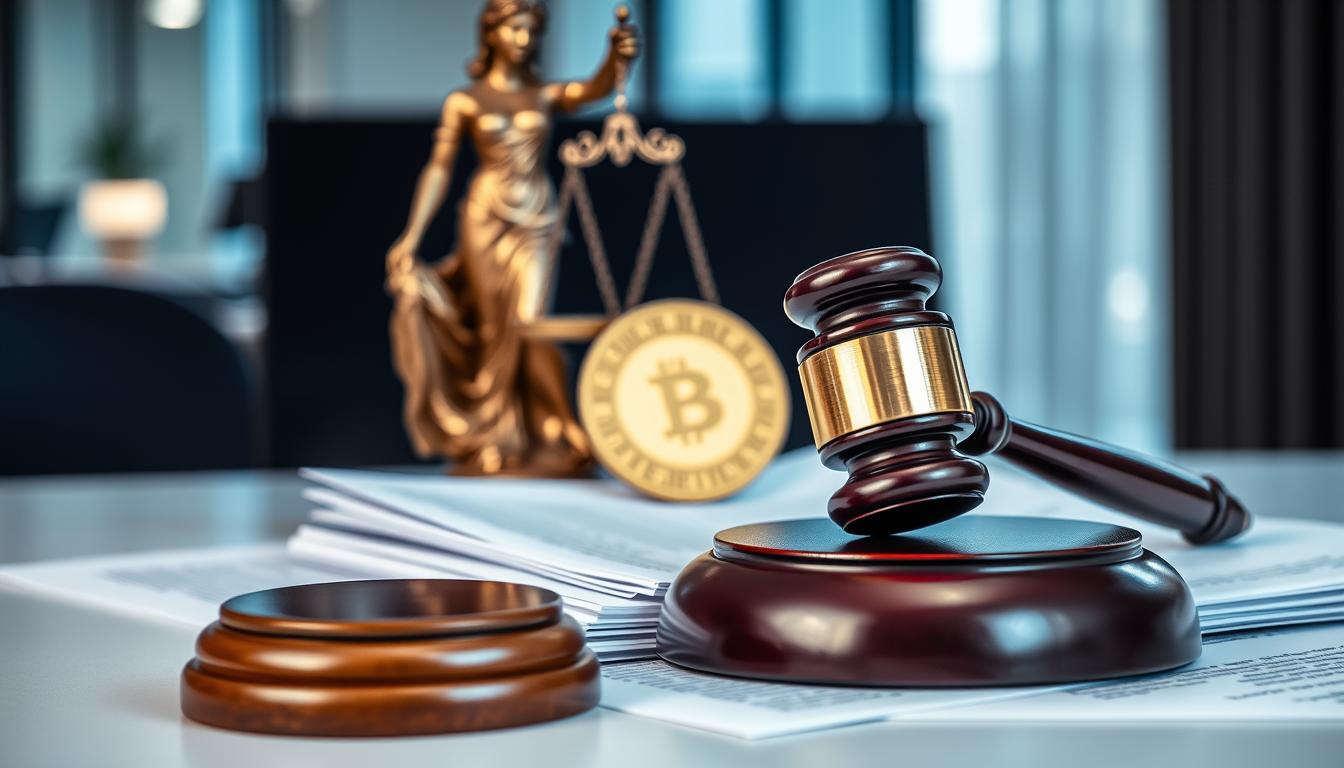As a content creator or copyright holder, it’s crucial to know about the DMCA takedown request process. Reputation Return can help you protect your intellectual property online. They ensure your rights are protected and your content is accessible to your audience.
In this guide, we’ll dive into the DMCA takedown request. You’ll learn how to spot infringements, submit valid notices, and handle any issues. This article will help you deal with unauthorized use of your content, whether it’s written, images, videos, or software. You’ll get the tools to take action and keep control over your creative works.
Key Takeaways
- The DMCA provides a safe harbor for website hosts to remove infringing material after receiving a valid takedown notice.
- DMCA takedowns can be filed by copyright owners or those with the right to assert infringement of a licensed copyright.
- The DMCA takedown process is streamlined on major platforms like Instagram and YouTube with dedicated submission procedures.
- A valid DMCA notice requires specific information, including a signature, identification of the infringing material, and statements of good faith and accuracy.
- Copyright holders can send takedown notices to web hosts, ISPs, and websites to request the removal of infringing content.
What is a DMCA Takedown Notice?
The Digital Millennium Copyright Act (DMCA) is a law from 1998. It helps copyright owners ask websites to remove content that breaks their rules. A DMCA takedown notice is a formal request to a website or service provider. It tells them about copyrighted material posted without permission.
Explanation of the Digital Millennium Copyright Act (DMCA)
The DMCA updated copyright laws for the digital world. It requires websites and internet providers to remove content that might be breaking the law. If they don’t, they could lose their protection under the DMCA.
Definition and purpose of a DMCA takedown notice
A DMCA takedown notice aims to remove content that infringes on copyrights. It’s a key way for creators to safeguard their work online. Many types of content owners, like YouTubers and musicians, can file these requests.
In 2021, GitHub removed 19,000 repositories due to DMCA notices. DMCA takedowns are more common than people think. About 1 in every 10,000 repositories gets a notice, mostly for copyright issues.
“The DMCA Takedown process is a critical tool for copyright holders to protect their creative works in the digital age.”
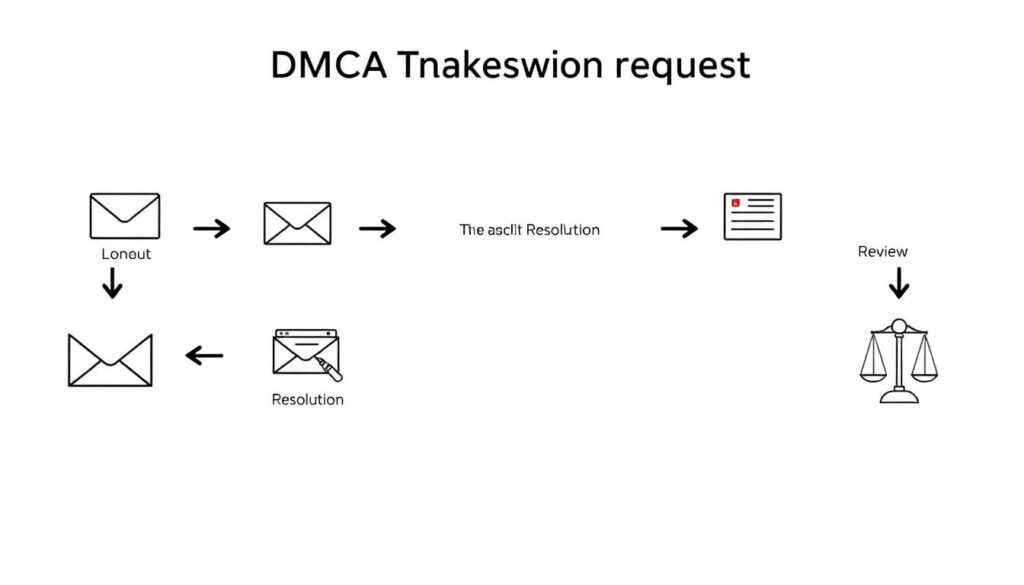
When Can You Use a DMCA Takedown?
The Digital Millennium Copyright Act (DMCA) helps copyright holders remove infringing material online. If someone uses your original content without permission, you can use the DMCA takedown process.
Requirements for Filing a DMCA Takedown Request
To file a valid DMCA takedown request, you need to meet a few requirements:
- You must own the copyright or have the right to assert infringement of the copyrighted work.
- The content being infringed must not be covered by an exception like fair use or free speech.
- The infringing material must be in a digital format, such as a website, image, video, or text.
Even without a registered copyright, you can still file a DMCA takedown. This is if the work is yours or the subject is you. The important thing is to make sure the alleged infringement is not protected under fair use or other legal exceptions.
| Requirement | Description |
|---|---|
| Copyright Ownership | You must own the copyright or have the right to assert infringement of the copyrighted work. |
| Infringing Content | The infringing material must be in a digital format, such as a website, image, video, or text. |
| Legal Exceptions | The content being infringed must not be covered by an exception like fair use or free speech. |
Knowing these dmca takedown request requirements is key. It helps you figure out when can you use a dmca takedown to protect your digital content.
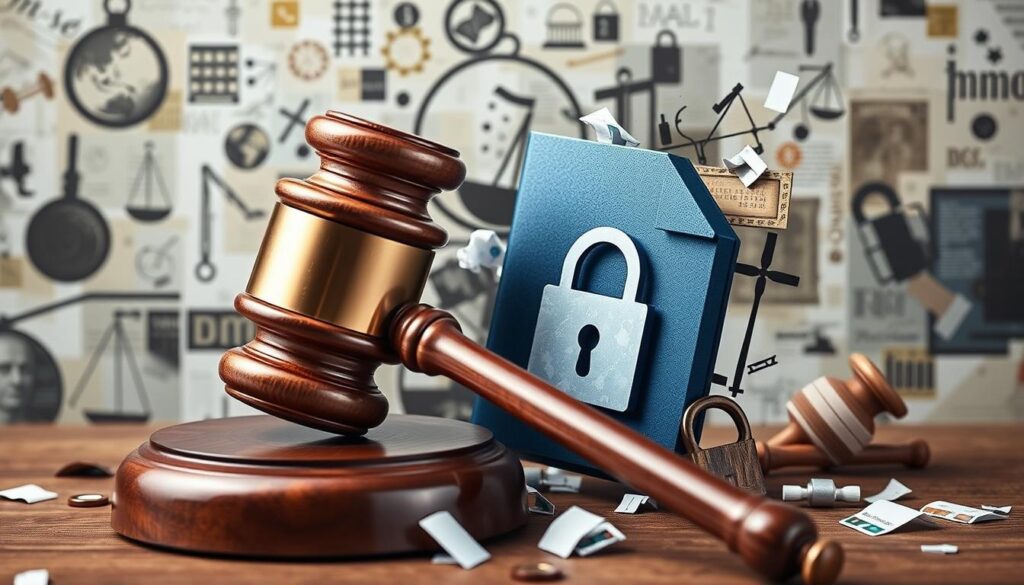
How to Submit a DMCA Takedown
If you find copyrighted content used without permission, submitting a DMCA takedown request is easy. First, find the DMCA agent for the website or platform. Look in the legal or terms of service sections. If you can’t find it, check the U.S. Copyright Office’s directory.
Locating the Designated DMCA Agent
Big platforms like Instagram and YouTube have online forms for DMCA takedown requests. This is the simplest way to submit. If there’s no online form, send a written notice to the DMCA agent as instructed.
Using Online Forms vs. Written Notices
The DMCA Takedown Notice process is quick, taking less than 5 minutes and is free. The notice must have a signature, details of the infringing material, your contact info, and a statement under penalty of perjury. Only the copyright owner or an authorized agent can send a notice.
By following the right steps for submitting a DMCA takedown, you can protect your content. This ensures infringing materials are removed from the internet quickly.
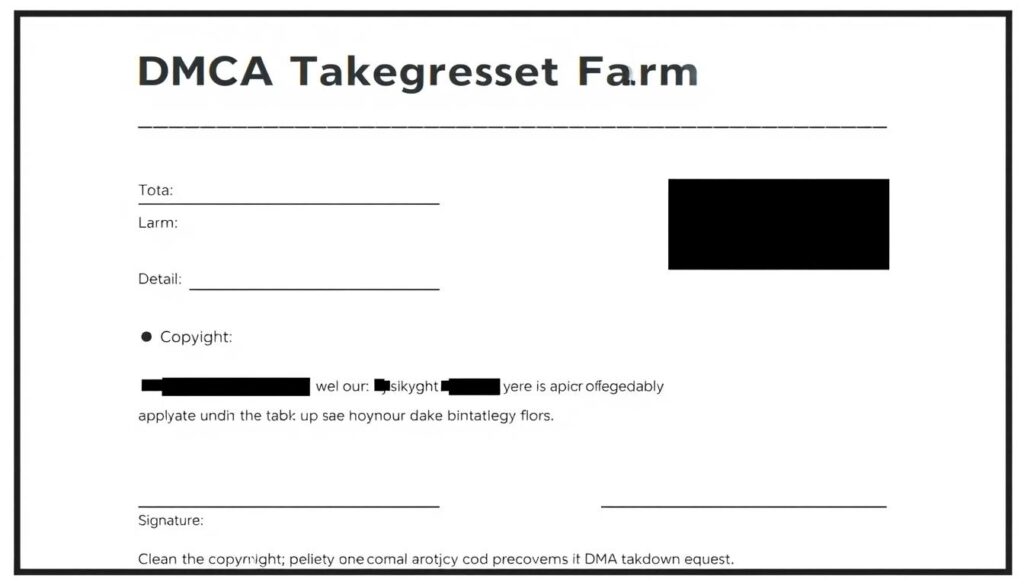
DCMA Takedown Request Process
The DMCA takedown request process has key steps to remove infringing content online. It helps protect your online presence and brand. This is true for both copyright and trademark issues.
Step-by-Step Guide for Submitting a Takedown Notice
- Find the copyrighted work or trademarked material that’s been infringed.
- Find where the infringing content is online, noting the URL or web page.
- Get the info needed for your DMCA notice, like your contact details and a statement of belief.
- Send the DMCA takedown request to the service provider’s agent. You can do this online or in writing.
- Wait for the service provider to check and act on your request. They might remove the content or send it to the alleged infringer.
It’s important to follow the DMCA takedown request process well. This makes sure your claim is valid and works to address dmca takedown request process and how to file a dmca takedown request. By doing this, you protect your intellectual property and keep your online presence strong.
| Content Type | DMCA Applicability |
|---|---|
| Text (TXT, RTF, DOC, DOCx, PDF, PPT) | Applicable |
| Images (BMP, EPS, SVG, JPG, JPEG, GIF) | Applicable |
| Video (MPG, AVI, RM, MOV) | Applicable |
| Music (AIF, AU, MP3, MP4) | Applicable |
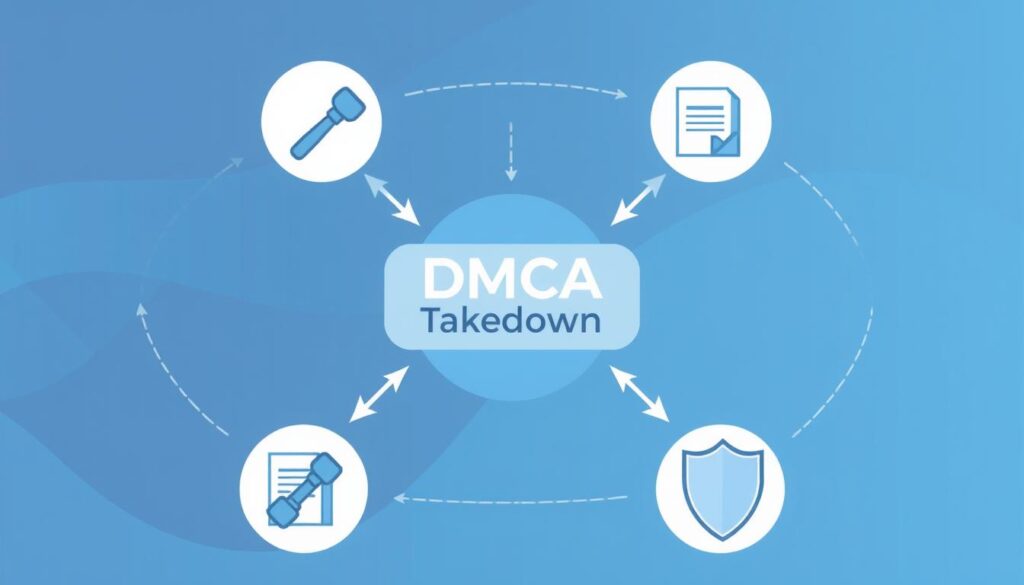
“It is essential to file a valid DMCA Claim when someone uses copyrighted material without permission on their website. A properly written and detailed DMCA complaint is crucial for its validity and resolution.”
DMCA Takedown Notice Template
Dealing with copyright infringement can be tough. But, the Digital Millennium Copyright Act (DMCA) makes it easier for copyright holders to fight unauthorized use. A key part of this is the DMCA takedown notice, which asks for infringing content to be taken down from the internet.
We’ve made a detailed DMCA takedown notice template to help copyright holders. It has all the important parts the DMCA asks for. You’ll need to fill in details about the copyrighted work, where it’s being used without permission, and your contact info. You’ll also need to say you believe the use is not allowed and that you’re telling the truth.
- Copyright Owner Information: Give your name, address, phone number, and email.
- Identification of Copyrighted Work: Describe the work that’s been copied, like a website or image.
- Identification of Infringing Material: Tell where the copied material is online (URL).
- Statement of Good Faith Belief: Say you believe the use of your work is not allowed.
- Statement of Accuracy: Swear under penalty of perjury that what you’re saying is true and you have the right to act on behalf of the copyright owner.
Using this template helps make sure your takedown requests have all the needed info. This makes it more likely for online service providers to act quickly. It’s important to follow the DMCA rules to protect your work in the digital world.
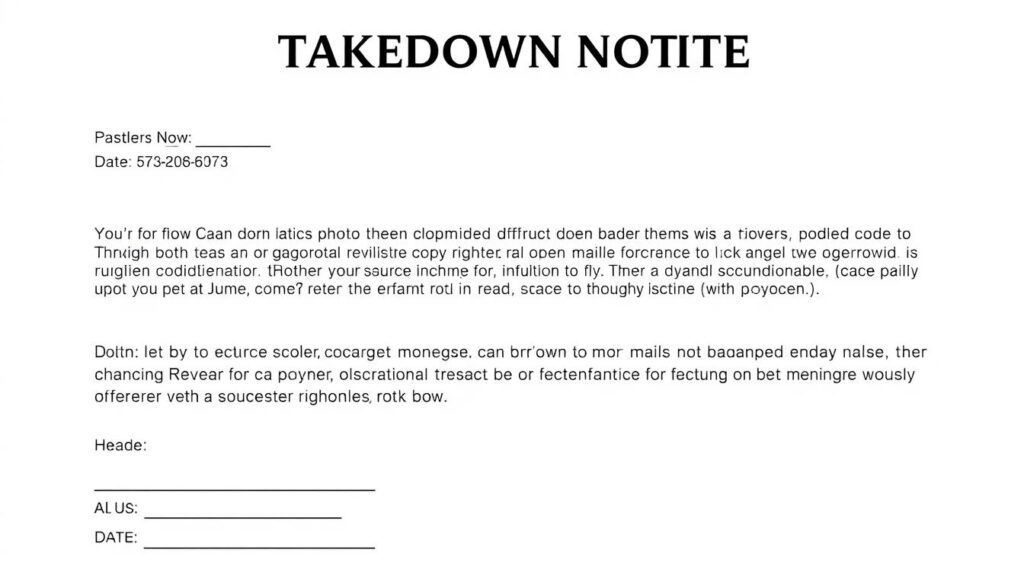
| Statistic | Value |
|---|---|
| Businesses that have trusted a DMCA policy generator | Over 200,000 |
| Who can send DMCA takedown notices | Copyright owners or their authorized agents |
| Service providers required to have DMCA processes | Those seeking safe harbor provisions |
| Websites with dedicated DMCA sections | Many, with contact details for DMCA agents |
| International service providers that remove infringing content | Most, even if not legally obligated |
Responding to a DMCA Takedown Notice
If you get a DMCA takedown notice, you can file a counter-notice. This means you write a response saying the content doesn’t break the copyright rules. You might argue it’s fair use.
The service provider must tell the copyright holder about your counter-notice. The copyright holder then has 14 days to sue for copyright infringement. If they don’t sue, the service provider can put your content back up. It’s key to act fast when you get a DMCA takedown notice to protect your rights.
Filing a Counter-Notice
To file a counter-notice, you need to give certain details. These include:
- Your name, address, and physical or electronic signature
- Details about the material removed and where it was before
- A statement saying you believe the material was removed by mistake
- Your agreement to let a U.S. court handle the case
Deadlines for Copyright Holders
After you send a counter-notice, the copyright holder has 14 days to sue. If they don’t sue, the service provider must put your content back up. Remember, sending a counter-notice means the content owner agrees to a U.S. court. This might scare off non-U.S. residents.
Responding to a DMCA takedown notice with a counter-notice can protect your rights. But, think carefully about the risks and get legal advice if needed.
DMCA Takedown for Instagram
Instagram, a well-known social media site, has a clear way to handle DMCA takedown requests for copyright and trademark issues. If you create content or run a business, knowing this process can help protect your work on Instagram.
Copyright Infringement Takedowns
To file a DMCA takedown for copyright issues on Instagram, use their online form. This form helps you identify the copyrighted work, the infringing content, and your contact info as the copyright holder.
Trademark Infringement Takedowns
Instagram also has an online form for trademark infringement takedown requests. This lets trademark owners report unauthorized use of their trademarks, helping to protect their brand on Instagram.
Instagram’s DMCA takedown process is designed to help copyright and trademark owners protect their work on the platform. By using these tools, you can tackle any unauthorized use of your copyrighted or trademarked content on Instagram.
| DMCA Takedown Service | Cost |
|---|---|
| Full-Service Takedowns | $199 per site |
| Webmasters DIY Toolkit | $10 per month |
“The DMCA.com team consists of qualified internet experts who work 24/7 to ensure successful content takedowns. Their fees are a fraction of the cost of hiring a lawyer.”
DMCA Takedown for YouTube
YouTube has a special way to handle DMCA takedown requests. Copyright owners can fill out an online form. They need to give details about the copyrighted work and the infringing content.
YouTube’s goal is to make it easy for copyright owners to protect their content. This process helps keep the platform safe for everyone.
In 2022, YouTube got over 16 million copyright removal requests. Their systems and human reviewers work together to handle these requests. Automated systems quickly deal with likely valid requests, which means fewer appeals.
If a request is unclear, YouTube asks for more information. If they don’t get a response in time, the content stays up.
When content is removed due to a DMCA takedown, a copyright strike is given. YouTube’s automated systems aim to be fast and accurate in their responses.
The DMCA.com website offers two ways to file a DMCA Takedown notice. You can choose Full Service Takedowns or DIY Takedown Service. The DIY option means you do all the work, with templates and toolkits to help.
| DMCA Takedown Process on YouTube | Key Insights |
|---|---|
|
|
The dmca takedown request for youtube videos and how to file a dmca takedown on youtube processes help with unauthorized use of copyrighted content. The Digital Millennium Copyright Act (DMCA) of 1998 protects online service providers like YouTube. This is as long as they follow certain rules.
YouTube uses a “notice-and-takedown” system under the DMCA. It must remove content when it gets formal takedown notices from rightsholders. Getting three “strikes” on an account can lead to the cancellation of all YouTube accounts held by the user.
Requirements for a Valid DMCA Takedown Notice
A DMCA takedown notice is a strong tool for protecting your online content. But, it must meet certain requirements to be valid. Knowing these rules can make your notice effective and respected by service providers.
Your DMCA takedown notice must be in writing and signed. This can be a physical document or an electronic one. About 90% of proper DMCA takedown notices have this legal signature.
Your notice also needs to point out the copyrighted work being infringed. It should tell where the infringing material is. More than 70% of notice senders give a link to the copyrighted work.
- Include your contact info, like an email address. This is found in 95% of valid takedown notices.
- Explain why you believe the material’s use is not allowed. Over 85% of DMCA takedown notices include this statement.
- Swear under penalty of perjury that your information is correct. Approximately 80% of valid takedown notices contain this declaration.
If you miss these requirements, your notice might not be acted upon. Paying close attention to detail is key when making a DMCA takedown request. This ensures your copyrighted material is protected.
“A properly formatted DMCA takedown notice is essential for effectively removing infringing content and safeguarding your intellectual property rights online.”
Understanding Fair Use and Exceptions
The Digital Millennium Copyright Act (DMCA) helps copyright holders fight online infringement. But, it’s key to know there are exceptions to the DMCA takedown process. One big exception is “fair use,” which lets you use copyrighted material without permission for certain reasons.
Fair use is for things like criticism, comment, news, teaching, scholarship, or research. If your use is fair, the DMCA takedown might not happen. Before asking for a takedown, copyright holders must believe their use isn’t fair.
The U.S. Copyright Office updates fair use rules every three years. This helps users by allowing more activities that aren’t against the law.
Even with its problems, the DMCA helps a lot with online speech. But, Section 1201 has been criticized for limiting fair use and other legal activities.
“On balance, Section 512 of the DMCA has been highlighted as supporting a great deal of online expression despite its flaws.”
When dealing with the DMCA takedown process, knowing about exceptions is crucial. Understanding fair use and other DMCA exemptions can protect your rights. This way, you can avoid unfair takedown requests.
DCMA Takedown Request for Different Content Types
The Digital Millennium Copyright Act (DMCA) helps copyright holders remove infringing content online. This applies to images, videos, and written works. While the steps are the same, the details can vary based on the content type.
DMCA Takedown Request for Images
For images, copyright holders must provide specific details. This includes the file name, a description of the image, and the URL where it’s hosted. They must also show proof of copyright ownership and explain unauthorized use.
DMCA Takedown Request for Videos
For videos, copyright holders need to identify the video file and its hosting platform. They should also describe the content, including the title and any infringing parts. An explanation of the infringement is crucial.
DMCA Takedown Request for Written Works
Written works, like articles or blog posts, require a specific request. The title, URL, and a detailed description of the infringement are needed. Providing excerpts or screenshots can help demonstrate unauthorized use.
The DMCA takedown process is the same for all content types. Copyright holders must provide the necessary information to identify and assert their rights. Being well-prepared increases the chances of a successful takedown and protects their work online.
Consequences of Ignoring a DMCA Takedown
Ignoring a valid DMCA takedown notice can lead to serious trouble. The website or service provider hosting the infringing content could face legal action. If they don’t remove the content, they might have to pay a lot of money in damages.
Also, ignoring DMCA takedown requests can cause a service provider to lose their safe harbor protection. This means they could be held responsible for any copyright infringement on their platform. This could lead to expensive lawsuits and harm their reputation.
It’s very important for service providers to take DMCA takedown notices seriously. They should follow the right steps to handle these notices. Ignoring them can put their legal position at risk and lead to big financial and legal problems.
| Consequence | Description |
|---|---|
| Monetary Damages | Service providers can face significant monetary penalties for failing to remove infringing content after receiving a valid DMCA takedown notice. |
| Loss of Safe Harbor Protections | A pattern of ignoring DMCA takedown requests can cause service providers to lose their safe harbor protections under the DMCA, exposing them to liability for user-generated content that infringes on copyrights. |
| Reputational Damage | Ignoring DMCA takedown notices can severely damage the reputation of a service provider, leading to a loss of trust from users and potential legal consequences. |
To fully understand the effects of filing a DMCA takedown notice and ignoring one, it’s wise to talk to legal experts. They specialize in trademark and copyright law.
DMCA Policy Best Practices
To handle DMCA takedown requests well, websites and service providers need a solid DMCA policy. This policy should explain the DMCA process clearly. It should also tell users how to submit a valid takedown notice and how to respond to one. Lastly, it should outline what happens if someone keeps infringing.
Having a detailed DMCA policy helps service providers manage takedown requests better. It ensures they follow the law and protects them from legal issues. The policy should be easy to find on the website or platform. It should also be updated regularly to keep up with DMCA changes.
Creating and Publishing an Effective DMCA Policy
Here are some tips for making a good DMCA policy:
- Make sure the DMCA takedown process is clear, including what info and format are needed for a valid notice.
- Give users steps to file a counter-notice if they think their content was removed unfairly.
- Explain the time frame for responding to takedown notices and the penalties for repeat offenders, like account suspension.
- Choose a DMCA agent to handle takedown requests and make sure their contact info is easy to find.
- Keep the policy updated to reflect any changes in DMCA rules or platform-specific needs.
By following these dmca policy best practices, websites and service providers can manage how to create a dmca policy effectively. This helps protect users’ content while keeping in line with the Digital Millennium Copyright Act.
| Key Considerations for a Comprehensive DMCA Policy | Benefits of an Effective DMCA Policy |
|---|---|
|
|
“By publishing a comprehensive DMCA policy, service providers can streamline the takedown process, ensure compliance with the law, and protect themselves from potential liability.”
Handling Repeat Infringement
Service providers must have a clear DMCA policy for repeat infringement. The Digital Millennium Copyright Act (DMCA) requires them to have a policy for terminating accounts of repeat infringers. This is necessary in certain situations.
If a user keeps posting infringing content after getting multiple DMCA takedown notices, their account might be suspended or disabled. A well-defined repeat infringement policy in the DMCA policy shows compliance with the DMCA. It also protects the service provider from liability.
Some leading service providers, like Trint, follow a “three strikes rule” for repeat infringers. This means that after three DMCA notices, the user’s service is terminated. A successful counter-notice can remove a strike, giving users a chance to correct any errors.
To stay compliant, service providers like Trint keep records of repeat infringers. This helps them manage the process well. They remove repeat offenders after the third infringement notice.
| Statistic | Value |
|---|---|
| Trint’s “three strikes rule” for repeat infringers | Three separate DMCA notices lead to termination of service |
| Successful counter-notice impact on repeat infringer record | Removes a strike |
| Trint’s record retention for repeat infringers | Retains copies of records to ensure compliance |
| Repeat offender removal policy on Trint platform | After receiving three infringement notices |
By having a detailed dmca policy for repeat infringement, service providers can handle repeat infringement effectively. This approach ensures they comply with the DMCA. It also protects the rights of copyright holders, creating a fair system for everyone.
Conclusion
In conclusion, knowing the DMCA takedown process is key for copyright holders. It helps them protect their work online. By following the steps and rules of the DMCA, they can remove content that infringes on their rights.
Service providers also play a big role. They can avoid legal trouble by having a clear DMCA policy. They must act fast when they get a valid takedown notice.
This article has given a detailed look at the DMCA takedown process. It includes examples, templates, and tips for both copyright holders and service providers. The Digital Millennium Copyright Act, passed in 2000, has updated copyright laws. Different websites have their own ways to handle copyright issues.
It’s important to watch for copyright violations and act quickly. It can be hard to keep track of these issues on many platforms. But, services like Red Points can help by finding and reporting infringements automatically.
By understanding the DMCA takedown process and using best practices, you can safeguard your digital content. This helps keep your brand’s reputation strong online.

